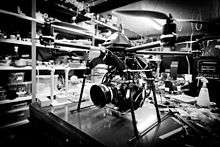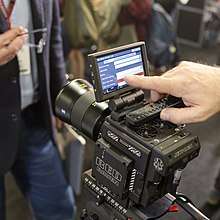Red Digital Cinema
Red Digital Cinema is an American company that manufactures professional digital cinematography cameras and accessories.
 | |
| Private | |
| Industry | Digital cinematography |
| Founded | 2005 |
| Founder | Jim Jannard |
| Headquarters | , |
Key people | Jim Jannard Jarred Land |
| Products | Red One, Epic, Scarlet, DSMC2, Scarlet-W & Red Raven cameras |
| Owner | Jim Jannard, Jarred Land |
| Website | www |
The company's headquarters are in Irvine, California, with studios in Hollywood, California. It has offices in London, Shanghai and Singapore, retail stores in Hollywood, New York and Miami as well as various authorized resellers and service centers around the world.[1]
History
Red Digital Cinema was founded by Jim Jannard, who had previously founded Oakley. As a self-described "camera fanatic" owning over 1,000 models, Jannard started the company with the intent to deliver an (relatively) affordable 4K digital cinema camera.[2][3] Jannard dates this idea to a time when he bought a Sony HDR-FX1 video camera and learned that the files had to be converted with software from Lumiere HD and were not viewable on Mac OS.[2] Lumiere HD's owner Frederic Lumiere collaborated with Jannard on developing an alternative and introduced him to Ted Schilowitz who became Red's first employee.[4]
The early team members engaged in undisclosed research on how to make a digital camera feasible for Hollywood productions. Part of this involved using 4K resolution instead of 2K which was most common at the time. Another technical hurdle was to achieve the focusing quality of DSLR cameras without sacrificing frame rate. Part of Red's solution to this problem was developing a sensor with a physical size comparable to that of analog film.[2] At the 2006 NAB Show, Jannard announced that Red would build a 4K digital cinema camera, called the Red One, and began taking pre-orders.
In March 2007, director Peter Jackson completed a camera test of two prototype Red One cameras, which became the 12-minute World War I film Crossing the Line.[5] On seeing the short film, director Steven Soderbergh told Jannard: "I am all in. I have to shoot with this." Soderbergh took two prototype Red Ones into the jungle to shoot his film, Che.[2] A short documentary, Che and the Digital Revolution was made about the Red camera technology that was used in the film's production.[6] The Red One first shipped in August 2007. One of the first television programs to shoot with it was the medical drama ER.[7]
In 2010, Red acquired the historic Ren-Mar Studios in Hollywood, and renamed it "Red Studios Hollywood".[8] By 2011, it had over 400 employees.[4] 2011 was also the year in which Panavision, Arri and Aaton announced that they would no longer be producing analog cameras. Red Digital Cinema and the Red One were widely credited as accelerating this transition in the industry.[7] Schilowitz responded to these reviews by saying "It was never our goal to kill film. Instead, we wanted to evolve it."[4]
On August 19, 2013 Jim Jannard announced his retirement from RED, leaving Jarred Land the current president to take over in his absence.[9]
In 2010, 5% of the top 100 grossing domestic films that were shot on digital video used Red cameras as their primary system. Their share increased to over 25% by 2016, but has declined since then.[10]
Cameras

Red One
The Red One first introduced in 2007 was Red Digital Cinema's first production camera.[11] It captures up to 120 frames per second at 2K resolution and 60 frames per second at 4K resolution.[12] Its "Mysterium" sensor was acquisitioned for use with the proprietary RAW format called Redcode. By 2010, Red began selling upgrades to a 14 megapixel sensor called the "M-X".[13] The Red One has been reviewed as having effectively the same quality as 35mm film.[2][14] The Red One was made out of cast iron and the body alone weighs in at 10 lbs (4.5 kg).
It was used to shoot Wanted, Che, The Informant, and The Girl with the Dragon Tattoo. In 2010, Red released the Red Epic which was used to shoot The Amazing Spiderman, The Hobbit, Prometheus, Pirates of the Caribbean: On Stranger Tides and The Great Gatsby as well as many other feature films.
DSMC system
In 2009, Red began releasing new cameras with an updated form factor compared to the Red One. Designed with the goal of facilitating either still images or video, depending on the mounting setup, Red called the concept DSMC for "Digital Stills and Motion Capture".[15] The first camera released for this system was Epic-X, a professional digital stills and motion capture camera with interchangeable lens mounts. After this a new camera line called Scarlet was introduced that provided lower end specifications at a more affordable price. Initially equipped with a 5K imaging sensor, upgrades were later offered to a 6K sensor with higher dynamic range called the "Red Dragon".[16]
DSMC2 system

The DSMC2 family of cameras was introduced in 2015 as the new form factor for all cameras up to 2020.[17] The Weapon 8K VV and Weapon 6K were the first two cameras announced within this line. They were followed by the Red Raven 4.5K and Scarlet-W 5K. Third-party capture formats, namely Apple ProRes and Avid DNxHD, were made available for these cameras.[18]
In 2016, an 8K sensor called "Helium" was introduced with the two cameras Red Epic-W and Weapon 8K S35. In early January 2017, this was given the highest sensor score ever, 108, by the DxOMark website.[19] Marvel Studios' Guardians of the Galaxy Vol. 2 was the first film to be released that was shot on the Weapon. The film was shot at the camera's full 8K resolution, and featured an equivalent workflow, supplanting director David Fincher's Gone Girl as the film with the highest-resolution post-production workflow.
Hydrogen One (modular smartphone system)
In 2017, Red announced their intentions to enter the smartphone market including planned features such as a 5.7" holographic display and integration with existing camera products.[20] On May 18, 2018, Red announced the Hydrogen One, with a release date in August 2018. Promised features included a holographic display, spatial sound, modular add-ons, compatibility with the Red camera program, and the launch of a streaming service.[21] As of 2019 promised modules vanished from RED's website for the phone itself, however it was dubbed the worst tech product of 2018, due to its outdated hardware and lack of capabilities, and thus was a complete commercial failure.[22] In late 2019, the company discontinued the product line.[23]

Other notable products
Lenses
Red offered S35 PL mount prime and zoom lenses for their cameras.
Primes
| Name | Focal length | Aperture | Minimum focal distance |
|---|---|---|---|
| PRO PRIME | 18mm | T1.8 | 4" |
| 25mm | T1.8 | 4" | |
| 35mm | T1.8 | 4" | |
| 50mm | T1.8 | 6" | |
| 85mm | T1.8 | 18" | |
| 100mm | T1.8 | 24" | |
| 300mm | T2.9 | 7.36 ft. |
Zooms
| Name | Focal length | Aperture | Minimum focal distance |
|---|---|---|---|
| PRO ZOOM | 17-50mm | T2.9 | 4" |
| 18-85mm | T2.9 | 8" | |
| 50-150mm | T2.8 | 8" |
Software
Red began selling its Redcine-X package for post-production workflow in 2009.[24] The process of decompressing the sensor data can be sped up with a Red Rocket accelerator card.[25] There is a downloadable SDK for working directly with the Redcode images, and another for controlling the cameras remotely.[26]
Redray
Announced in 2012, the Redray Player was the first stand-alone device capable of providing 4K content to compatible 2D or 3D displays. Using a 1TB internal drive for storage, the Redray plays 4K or HD media in the Redcode format. The player uses 12-bit 4:2:2 precision.[27] A cinema laser projector in the same family was also announced in 2012 but never released.[28]
Lawsuits
On August 18, 2008, Red filed a lawsuit against the electronics company LG over its use of the name Scarlet.[29] Red accused LG "... of taking the 'Scarlet' brand name from the camera company" after Red had denied LG's request to use it.[30]
On September 23, 2011, Jannard announced that his personal email account was compromised by former Arri executive Michael Bravin.[31] A lawsuit against Arri and Bravin was filed at the end of 2011, and settled and dismissed in 2013.[32]
On June 27, 2012, Red sued Wooden Camera, a manufacturer of third party accessories, for patent infringement.[33]
In February 2013, Red filed for an injunction against Sony, claiming that several of its new CineAlta products, particularly the 4K-capable F65, infringed on patents the company held. They requested that Sony not only be forced to stop selling the cameras, but that they be destroyed as well.[34] Sony filed a countersuit against Red in April 2013, alleging that Red's entire product line infringed on Sony patents. In July 2013, both parties filed jointly for dismissal, and as of July 20, 2013, the case is closed.[35]
On March 2, 2017, Red filed a lawsuit against the maker of JinniMag, a third party copy of the Red Mini Mag.[36] Videos posted on the Jinni.Tech YouTube channel have accused Red Digital Cinema Cameras of lying to their customers and possibly obtaining their patents by deceiving the USPTO.[37]
In May 2019, Apple Inc. filed a lawsuit against Red.com, LLC over several patents relating to digital cinema cameras and sensor processing.[38] Apple lost the case in November 2019. Apple argued that the patents related to REDCODE RAW were “Unpatentable”, but the judge ruled that Apple's legal team had not provided sufficient evidence to back up their claims.[39]
References
- "Worldwide Locations - RED Digital Cinema". www.red.com.
- "Analog Meets Its Match in Red Digital Cinema's Ultrahigh-Res Camera". WIRED.
- "The History of RED Digital Cinema". red.com.
- Gomes, Lee (December 19, 2011). "Red: The Camera That Changed Hollywood". MIT Technology Review. Retrieved April 22, 2018.
- SnakesOnAnAfricanPlain (August 10, 2007). "Crossing the Line (2006)". IMDb.
- Che: The Criterion Collection (Blu-ray) Archived January 21, 2010, at the Wayback Machine by Christopher Long, DVD Town, January 16, 2010
- Kantilaftis, Helen (August 7, 2015). "How RED cameras changed the game". New York Film Academy. Retrieved April 22, 2018.
- "RED buys Ren Mar Studios in Hollywood". Studio Daily.
- "RED's CEO Jim Jannard Has Resigned, Jarred Land To Take Helm". Fstoppers. August 19, 2013. Retrieved August 10, 2018.
- "The use of digital vs celluloid film on Hollywood movies | Stephen Follows". Retrieved December 16, 2019.
- "The Red Digital Camera Company". digital-intermediate.co.uk.
- "RENTALS". simdigital.com. Archived from the original on August 26, 2014.
- Twarog, Zbigniew (June 14, 2010). "New Mysterium-X Sensor for RED One Camera". Rule.
- Charlie White. "Red One Digital Cinema Camera Price List Now On Line, Still Not Shipping". Gizmodo. Gawker Media.
- "RED Announces DSMC". outdoorphotographer.com.
- "RED Dragon is Finally Here: Upgrade Schedule Announced, SCARLET Will Get Dragon Upgrade". No Film School.
- "Obsolescence..." www.reduser.net.
...making a commitment right now that the DSMC2 form factor will stay the same until at least 2020.
- Fauer, Jon (October 11, 2016). "RED 8K HELIUM Super35mm Cameras". Film and Digital Times. Retrieved April 22, 2018.
- DxO. "RED Helium 8K DxOMark Sensor Score: 108 — A new all-time-high score! | DxOMark". Retrieved January 13, 2017.
- Allard, Matthew (July 7, 2017). "The Red Hydrogen – niche phone for the faithful or breakthrough tech for the masses?". News Shooter. Retrieved April 22, 2018.
- "The $1,200 Red Hydrogen One phone is coming to Verizon and AT&T this summer, but why?". PCWorld. Retrieved May 18, 2018.
- "RED's Hydrogen One was the worst tech product of 2018". MashableUK. Retrieved October 25, 2019.
- "Red quits the smartphone business after a single, terrible phone". Ars Technica. Retrieved October 26, 2018.
- Scott Simmons. "Pro Video Coalition - RED announces REDCINE-X™". provideocoalition.com.
- Peters, Oliver (February 18, 2012). "A RED post production workflow". DV Magazine. Retrieved April 22, 2018.
- "Developers". red.com.
- "REDRAY Has Arrived". red.com.
- "REDray 4K cinema laser projector and player eyes-on". engadget.com.
- "Red brings the trademark pain against LG's Scarlet HDTV". Engadget. Retrieved June 21, 2012.
- "Head-2-Head News". H2hreviews.com. October 1, 2008. Retrieved June 21, 2012.
- "Michael Bravin Charged with email hacking!". Reduser.net. September 22, 2011. Retrieved June 21, 2012.
- "Movie-Camera Maker Red Accuses Rival Arri of Corporate Espionage". Reuters. December 29, 2011.
- "Red Sues Wooden Camera Over Patent Infringements, Sunglasses & More". Cinescopophilia. June 27, 2012.
- Dent, Steve. "Red sues Sony over patents, wants disputed F-series cameras 'destroyed' (updated)". Engadget.com. Retrieved November 30, 2013.
- Krishnan, Bala (July 29, 2013). "Sony, Red End Patent Dispute - Intellectual Property Insiders". Ipinsiders.com. Retrieved November 30, 2013.
- "Jinni Tech, Ltd vs Red.com, Inc" (PDF). www.jinnimag.com. Archived from the original (PDF) on July 21, 2017. Retrieved September 23, 2019.
- Jinni.Tech (August 13, 2019). "RED DIGITAL CINEMA - Things you only thought you knew". YouTube.com. Retrieved August 13, 2019.
- "Inter Partes Review of U.S. Pat. 9,245,314". May 6, 2019.
- https://developer.uspto.gov/ptab-web/#/search/documents?proceedingNumber=IPR2019-01065
External links
| Wikimedia Commons has media related to Red Digital Cinema Camera Company. |
- Official website
- Red Camera on the Movie Making Manual at WikiBooks
- Insides of a Red Epic-M to nbe
- Red One Pocket Guide
- Red Epic Pocket Guide